AI Commentary in Esports: Technology, Impact, and Future Trends
Updated On: November 13, 2025 by Aaron Connolly
AI Commentary: Definition and Core Concepts
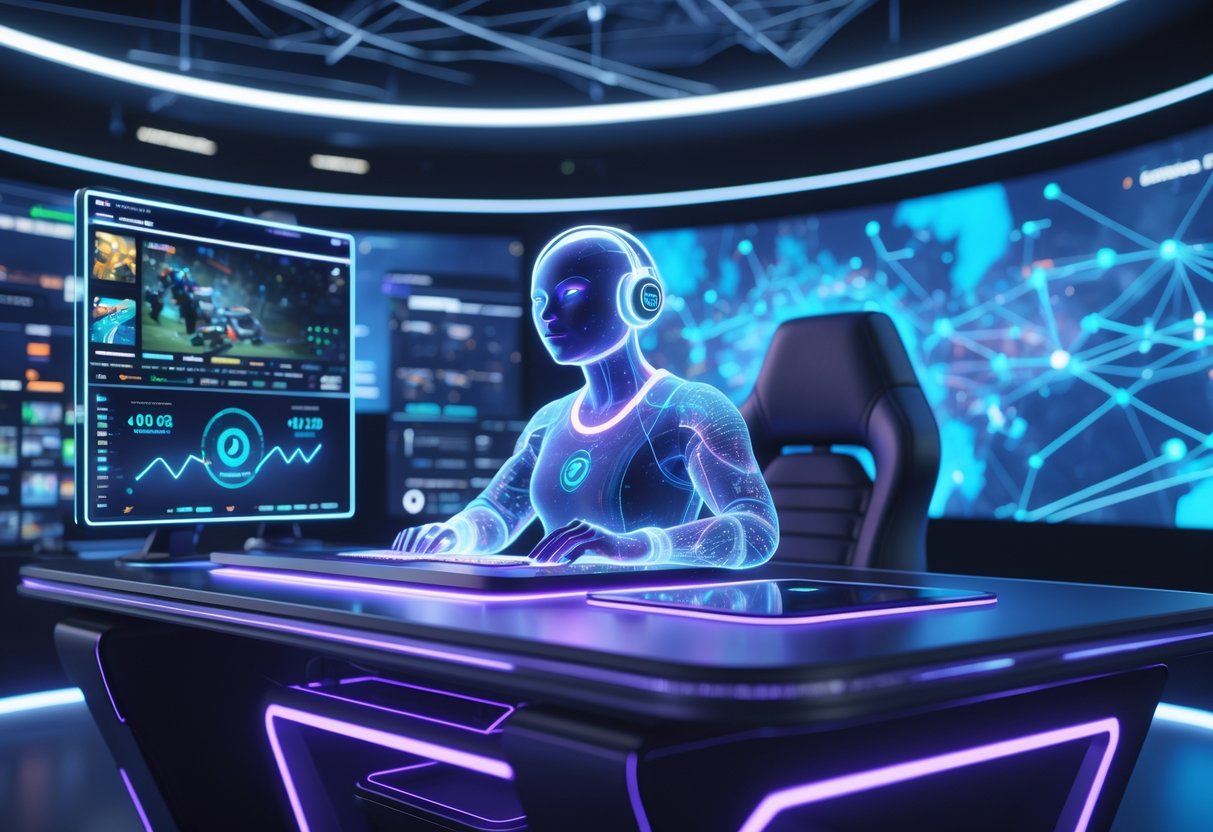
AI commentary taps into machine learning models to generate live analysis and narration for esports matches. The technology chews through gameplay data, visuals, and stats to deliver professional-level commentary—no human casters required.
Difference Between Traditional and AI Commentary
Traditional esports commentary depends on human casters who watch matches and share insights based on their experience. These folks add personality and unique takes, but they need lots of resources and sometimes, well, they’re not always consistent.
AI commentary? Totally different:
- It processes thousands of data points every second.
- The analysis stays consistent and unbiased.
- AI works nonstop, no coffee breaks.
- It’s way cheaper than hiring a team of pros.
Here’s a quick comparison:
| Traditional Commentary | AI Commentary |
|---|---|
| Subjective opinions | Data-driven insights |
| Limited to human reaction speed | Instant analysis of complex plays |
| Requires experienced casters | Uses pre-trained models |
| Higher production costs | Automated and scalable |
Human commentators nail storytelling and connect emotionally with viewers. AI, on the other hand, delivers precise stats and tracks every player at once—never missing a beat.
Role of Artificial Intelligence in Modern Esports
Artificial intelligence is shaking up esports broadcasting by analyzing gameplay footage frame by frame. Modern AI systems spot key events—team fights, big objectives, and clutch plays—on their own.
AI handles several big jobs:
- It grabs real-time data straight from game APIs.
- It recognizes in-game actions and events.
- It writes commentary scripts on the fly.
- It creates dynamic overlays, showing stats and win chances.
Developers train machine learning models on thousands of pro matches to help them understand game strategies and mechanics. These models catch patterns that humans might overlook, like sneaky positioning or economic swings.
But let’s be honest—AI commentary still can’t match the emotional depth or storytelling flair of a seasoned human caster.
Evolution of Sports Commentary with AI
Sports commentary started experimenting with AI tech around 2020. Esports jumped in first because the digital data is just so rich. Those early systems? They just summarized the basics, nothing fancy.
Here’s how things have progressed:
- 2020-2021: Basic automated match summaries showed up.
- 2022-2023: Real-time, simple commentary became possible.
- 2024-2025: Systems now offer advanced analysis and even customizable personalities.
Lately, AI commentary has added multilingual support and lets viewers pick a style—analytical, entertaining, or beginner-friendly.
Tech is moving fast. Now, AI commentary combines computer vision, natural language processing, and game knowledge to deliver analysis that’s getting close to what humans can do.
How AI Commentary Works in Esports
AI commentary systems mix real-time data processing, machine learning, and voice synthesis to automate esports match narration. They analyze gameplay as it happens and generate commentary that sounds pretty close to the real thing.
Real-Time Data Processing
Real-time data integration sits at the heart of AI commentary. The tech pulls info straight from game APIs during live matches.
For games like League of Legends, AI connects to Riot’s API for instant stats, item buys, and match events. Counter-Strike 2 matches feed the system data on kills, bomb plants, and economy.
All this happens in milliseconds. If a player lands a headshot at 00:45, the AI catches it right away. It also checks the player’s recent performance and how important the match is.
Main data sources:
- Player movement and positions
- Weapon stats and accuracy
- Economic status (gold, credits, resources)
- Objective control (towers, map sites, etc.)
- Past performance numbers
Modern systems juggle multiple streams—video and game data—at once. That way, the commentary always matches what’s on screen.
Machine Learning and Deep Learning Models
Machine learning models are the brains behind AI commentary. Deep learning helps the system understand game situations and react appropriately.
Generative AI models, like the GPT family, analyze gameplay patterns. They learn from thousands of pro matches to figure out what makes good commentary. The models know when to hype up a play or just call it routine.
Training data includes pro commentary, match histories, and community lingo. AI picks up on esports slang—”smurfing” in Valorant or “int-ing” in League—without missing a beat.
Computer vision models work with language models to spot key visuals in the game. If someone pops an ultimate in Overwatch 2, the system recognizes it and comments right away.
These models can:
- Write context-aware scripts
- Adjust tone based on match hype
- Analyze player performance
- Offer strategic insights
- Report stats without bias
Voice Synthesis and Natural Language Generation
Natural language generation turns raw data into smooth commentary scripts. The AI structures info into stories that actually flow.
Voice synthesis delivers the final audio. Modern text-to-speech tech sounds surprisingly human, with pacing and emotion that shift as the match heats up.
Personalized commentary styles include:
- Analytical for deep dives
- Hype for big moments
- Educational for new fans
- Casual for entertainment
It all happens live. As the game unfolds, AI picks the right phrases and builds sentences on the spot. It keeps things conversational and fresh with up-to-date stats.
Top systems even handle 50+ languages at once. Tournaments can reach global fans instantly with automatic translation and localized voices.
Human oversight still matters, though. Many setups use a hybrid approach: AI covers the basics, while human casters jump in for the big plays and strategy.
Key Technologies Powering AI Commentary
Several advanced technologies come together to create real-time commentary that actually feels pretty natural. Computer vision analyzes gameplay frames to spot key moments, while language models generate the narration.
Computer Vision in Gameplay Analysis
Computer vision is the backbone of AI commentary. It processes thousands of game frames every second to catch things like eliminations, objectives, and special abilities.
Developers train these models on specific game mechanics. For Counter-Strike, the system spots headshots, bomb plants, and clutch plays. In League of Legends, it tracks champion movement, team fights, and ward drops.
Modern systems even catch subtle plays that most viewers would miss. They see flanks, low health, and tactical rotations before anyone else.
This frame-by-frame analysis builds the data commentary systems need. Without it, AI would totally miss the context for meaningful analysis.
Integration of Environment Variables
Environment variables add context, turning simple event detection into smart commentary. These include scores, player stats, tournament stakes, and team history.
AI grabs real-time data from game APIs, like:
- Current economy in shooters
- Ultimate cooldowns in hero games
- Map control percentages
- Player performance metrics
Integration happens instantly. If a player makes a risky move, the AI considers their team’s position, the match clock, and recent trends to craft the right commentary.
This context lets AI explain why a play matters. A basic elimination becomes huge if it wins match point or breaks the bank.
Speech-to-Text and Text-to-Speech Systems
Modern speech synthesis delivers commentary that matches the excitement of the action. State-of-the-art text-to-speech adjusts tone and pacing for the moment.
These systems can generate different voice styles. Some focus on analysis, while others bring the hype. The tech even handles multiple languages at once.
Speech-to-text lets AI listen to human co-casters and react in real time. This creates hybrid broadcasts—AI brings the stats, humans bring the energy.
The best systems tweak their speech as the match heats up. When things get intense, they talk faster and raise the pitch to match the crowd.
Major Use Cases and Applications in Esports
AI commentary is changing how we watch competitive gaming. It brings real-time narration, tactical insights, and personalized viewing to the table. These systems dish out instant analysis and can even adapt to what viewers want.
Automated Play-by-Play Narration
AI tracks game events live and delivers instant commentary—no humans needed. The system follows player moves, kills, objectives, and match flow to create spoken or written play-by-play.
The big win here? 24/7 coverage. Human commentators can’t work every match, but AI can. Smaller tournaments and local events finally get solid commentary.
AI uses computer vision to see everything on screen—health bars, scores, positions. It then turns this into natural language narration.
But there are still some hurdles:
- Delivery can sound robotic at times.
- Subtle strategies might get missed.
- Team dynamics aren’t always clear.
- The vocabulary is still pretty basic for complex plays.
Voice synthesis is getting better, though. Modern AI voices sound more natural and can ramp up excitement when needed.
Context-Aware Tactical Analysis
AI commentary shines when it comes to deep strategic insights. It analyzes tons of game data to spot patterns humans might overlook.
The system compares current plays to thousands of past matches. It can quickly calculate win chances, point out smart strategies, and highlight mistakes.
Key features:
- Stat comparisons between teams and players
- Real-time win probabilities
- Pattern recognition for team strategies
- Performance tracking during matches
AI juggles multiple data streams at once. It keeps tabs on economy in CS, ultimates in Overwatch, and positioning in League.
Gaming expert James Connolly says AI analysis makes complex strategies easier for new viewers to follow. The system breaks down why moves matter, helping everyone learn as they watch.
This makes esports broadcasts more educational and accessible—even for folks who are totally new.
Customisable and Personalised Commentary
AI can tweak its commentary style to fit each viewer. This personalization totally changes how we watch esports, making it fit different audiences.
Viewers pick their mode. Beginners get basics explained. Experienced players get deep tactical breakdowns. Casual fans might want a more relaxed, entertaining vibe.
Personalization options:
- Simpler or more advanced commentary
- Focus on favorite players or teams
- Language and region choices
- Audio mixing with game sounds
The system learns from what you watch. If you always follow certain teams, it gives you more details about them.
We can ask for more or less analysis based on our own gaming knowledge. New fans get the basics, while veterans get stats and meta-game talk.
This flexibility opens up esports to everyone. Parents can turn on family-friendly commentary. Analysts can dive deep with extra stats and overlays during matches.
AI Commentary Enhancing Competitive Gaming
AI commentary is shaking up competitive gaming. It delivers detailed analysis of player performance, drops coaching tips mid-match, and keeps viewers hooked.
These systems crunch thousands of data points every second. Human commentators just can’t keep up with that pace.
Analysing Player Performance
AI commentary tools break down player performance with a level of detail that’s honestly wild. They track movement, reaction times, and decisions across entire matches.
Key Performance Metrics AI Tracks:
- Accuracy with each weapon
- Positioning around objectives
- Resource management
- Team coordination timing
AI systems spot tiny micro-movements that set pros apart from everyone else. In Counter-Strike, for example, the AI will notice if a player’s crosshair is just a couple pixels off.
The tech offers instant feedback on tactical choices. If someone makes a weird rotation in League of Legends, the AI explains the odds of it working out based on thousands of past games.
Teams use these insights right after matches. Players get detailed breakdowns within minutes, not hours.
Coaching and Training Assistance
AI commentary acts like a 24/7 assistant coach for teams and solo players. It picks up on gameplay trends that human coaches might miss during the action.
Training Applications:
- Real-time mistake spotting
- Suggestions for build orders
- Advice on map control
- Analysis of team comms
We’ve seen semi-pro teams use AI to review scrims. The system flags moments when communication falls apart or someone misses a key callout.
The tech adapts to all skill levels. Newbies get basic tips, while veterans get deep dives into meta changes and counter-strats.
Cost savings are real for smaller orgs. Instead of hiring a bunch of analysts, teams can use AI commentary for £50-100 a month—way less than the £2,000+ you’d pay a human.
Improving Viewer Engagement
AI commentary personalises broadcasts, which keeps people watching. Viewers can pick commentary styles that fit their knowledge and interests.
Engagement Features:
- Generates commentary in multiple languages
- Explains basics for beginners
- Offers deep tactical breakdowns
- Shows interactive stats overlays
New fans get help understanding game mechanics as they happen. If someone nails a tricky combo in Street Fighter, the AI explains the inputs and timing.
Platforms let viewers pick commentary tracks. Casual fans might want a fun, story-driven style, while hardcore folks go for the tactical stuff.
The tech also auto-generates highlight reels. It finds clutch moments and awesome plays seconds after they happen, making it easy to share on social media.
Viewer retention actually improves when AI adds context for tough plays. Instead of scratching their heads, people get clear explanations and start to appreciate high-level competition more.
Popular Esports Titles and Platforms Using AI Commentary
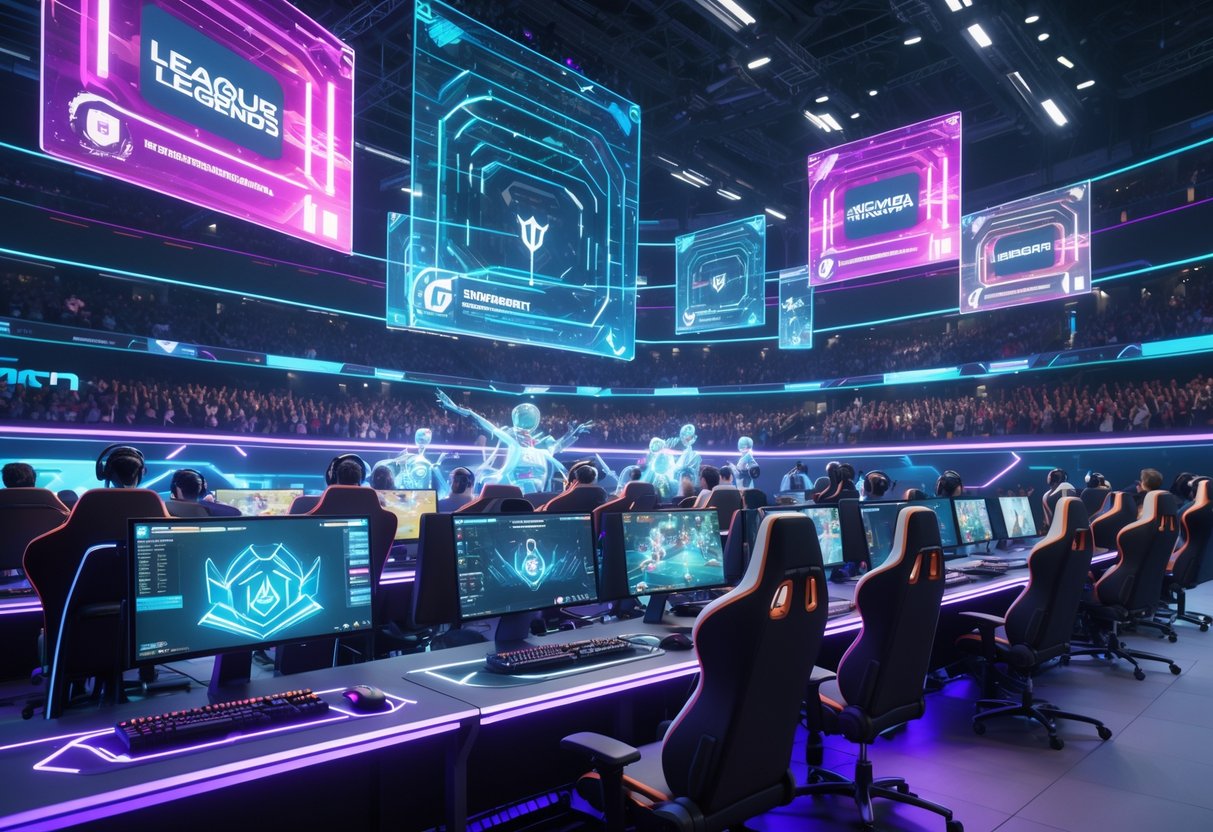
Big games and platforms are jumping on AI commentary. Riot Games is leading the charge with advanced data integration for real-time match analysis.
League of Legends
League of Legends really benefits from Riot’s API, which feeds live data straight to AI commentary tools. The structured format of the game makes it perfect for automated analysis.
AI tracks champion picks, build paths, and objectives. Key metrics like gold lead, vision score, and team fights get broken down instantly.
Streaming platforms now offer AI-powered broadcasts for big tournaments. These systems spot huge moments—like baron steals or pentakills—almost immediately.
During the laning phase, the tech shines. AI explains matchups and predicts power spikes based on builds and levels.
Fortnite
Fortnite’s chaotic battle royale style is a real test for AI commentary. The building mechanics and 100-player lobbies create some wild scenarios.
Omnic Forge has made big strides with Fortnite coaching AI. Players using it improved healing efficiency by 104% and took 32% less damage.
AI commentary tracks storm movement, player positions, and elimination patterns. It highlights clutch moments, like last-second builds or sneaky third-party plays.
Building sequences, though, are still tough for AI to explain. Complex edits and advanced building tricks often stump current systems.
Notable Contributions from Riot Games
Riot Games offers one of the best data APIs in the business. Their League of Legends API gives real-time access to stats that AI commentary depends on.
The company has tested internal AI commentary during pro matches. These tests focus on objective control analysis and breaking down team comps.
Riot’s data includes champion stats, item builds, and historical performance. AI uses this context to explain player decisions and match outcomes.
Their API updates within seconds of in-game events. This lets AI commentary stay in sync with live broadcasts.
AI Commentary and the Esports Industry
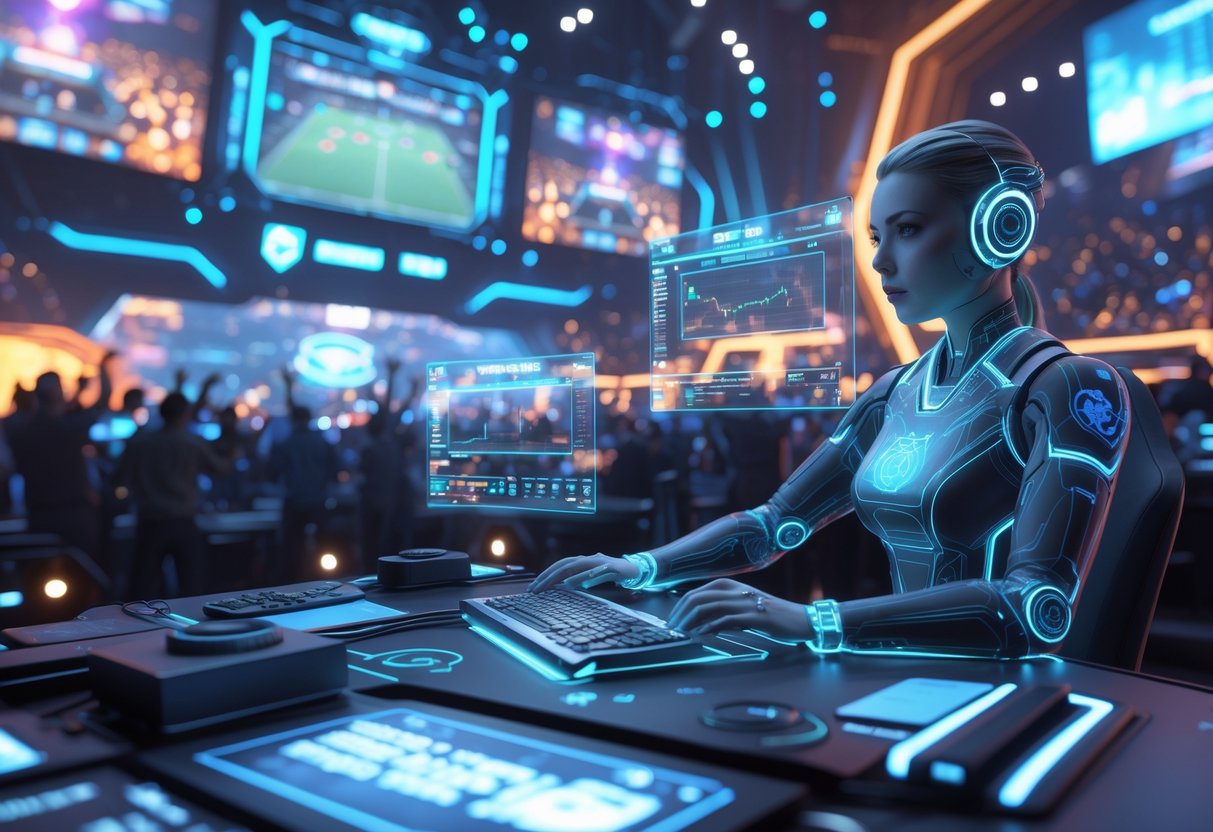
The esports industry is jumping on AI commentary to cut production costs and meet content demands. This tech is opening up pro-level analysis to smaller tournaments and solo creators, changing how we all watch competitive gaming.
Growth of AI in the Esports Sector
Esports is on track to break $6 billion by 2027, and AI commentary is a big part of that growth. Major platforms are adding AI tools to handle the flood of content.
AI now analyses gameplay in real time using computer vision and language models. It spots key moments—like ultimates in Overwatch 2—or follows player movement across maps.
Current AI applications include:
- Real-time data from game APIs
- Automated highlight reels
- Instant translation for global viewers
- Custom voice personas for different commentary vibes
Teams use AI to make practice bots that copy specific opponents’ playstyles. It’s a peek at how AI will keep evolving past just commentary.
The tech handles repetitive analysis, letting human casters focus on the fun stuff and deeper strategy.
Content Democratisation and Cost Efficiency
AI commentary is making it possible for smaller events and creators to produce pro-level content. Traditional broadcasts need analysts, editors, and pricey software—most can’t afford that.
Now, indie creators and regional leagues are turning out studio-quality content with AI tools. The tech generates smart narration, tactical breakdowns, and overlays on its own.
Cost benefits include:
- Automated post-game recaps
- Multiple regional broadcasts at once
- Fewer expensive commentary hires
- 24/7 content output
Fans can upload their own games and get pro-level breakdowns. Esports analysis isn’t just for the big leagues anymore.
Small communities now match the production value of major broadcasts. This levels the field for up-and-coming talent and niche games.
Technical Challenges and Limitations
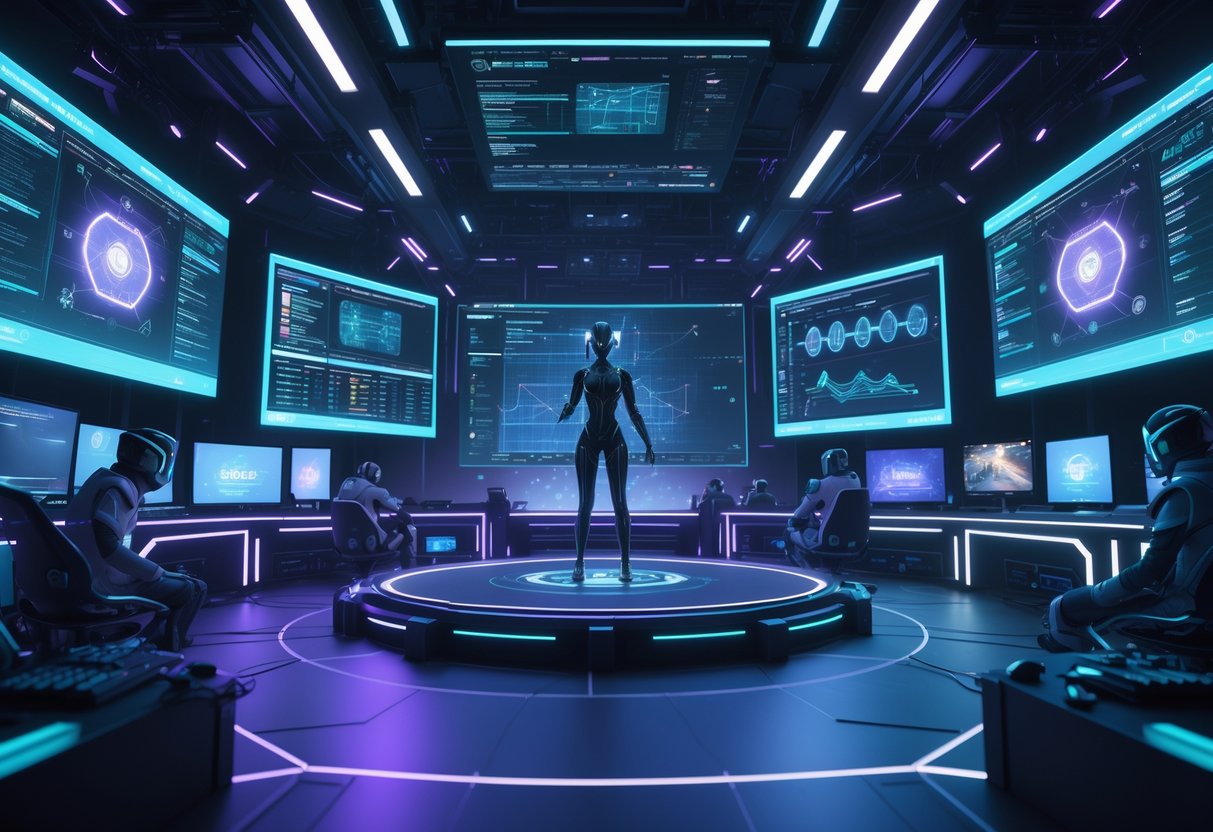
AI commentary faces some real hurdles—speed, accuracy, and ethics. These problems affect everything from spotting real-time events to protecting player privacy.
Data Quality and Latency Issues
Real-time esports commentary needs split-second processing of massive data. AI has to analyse game states, player positions, and interactions in milliseconds.
Processing Speed Requirements:
- Game events happen in under 100ms
- Commentary needs to generate within 500ms
- Network delays add 50-200ms
Current AI models often miss key moments or deliver analysis that’s already old by the time it airs.
Data quality is all over the place. League of Legends gives structured APIs, but some games barely share event data. Developers end up building custom solutions for each title.
Key Technical Barriers:
- Incomplete data feeds
- Unpredictable network conditions
- Hardware limits
- Multi-threaded coordination headaches
AI needs thousands of hours of pro gameplay with expert commentary to really learn context and timing.
Nuanced Understanding of In-Game Events
AI commentators still miss the deeper strategy that experienced fans want. Sure, they can call out kills and objectives, but subtle positioning or mind games? Not so much.
Context is tough for AI. When a player buys an odd item, humans might get the reasoning. AI usually just flags it as a mistake or ignores it.
Common Recognition Failures:
- Bait plays and fake retreats
- Shifts in momentum
- Player-specific habits
- Team comms breakdowns
AI-generated language often lacks personality. It gets the facts right but misses the storytelling that brings commentary to life.
The tech can’t shift its style for different audiences. Pro analysts want deep dives, casuals want basics, but AI tends to use one-size-fits-all commentary.
Missing Capabilities:
- Predictive insights beyond patterns
- Comparing strategies across games
- Bringing in historical context
- Adjusting explanation depth
Ethical and Privacy Considerations
Player consent for AI analysis is a legal grey area. These systems break down individual performance, sometimes exposing weaknesses or habits without permission.
Data protection laws differ everywhere. Europe’s GDPR wants explicit consent, but other places have their own rules. Tournament organisers have to juggle all this.
Privacy Concerns Include:
- Biometric data from cameras
- Voice analysis
- Behavioural profiling
- Performance prediction
AI can pick up biases from training data. If the original commentary had stereotypes, the AI keeps them—and sometimes makes them worse.
People want transparency. When AI makes claims about player performance or strategy, it needs to back them up.
Regulatory Challenges:
- Cross-border data issues
- Managing consent
- Algorithm audits
- Spotting and fixing bias
Commercial interests could sway AI commentary. Sponsors or betting companies might push for certain narratives or downplay bad press.
Replacing human commentators isn’t just a tech issue—it’s an ethical one. Organisers have to weigh cost savings against the impact on real jobs.
Impact of AI Commentary on Esports Communities
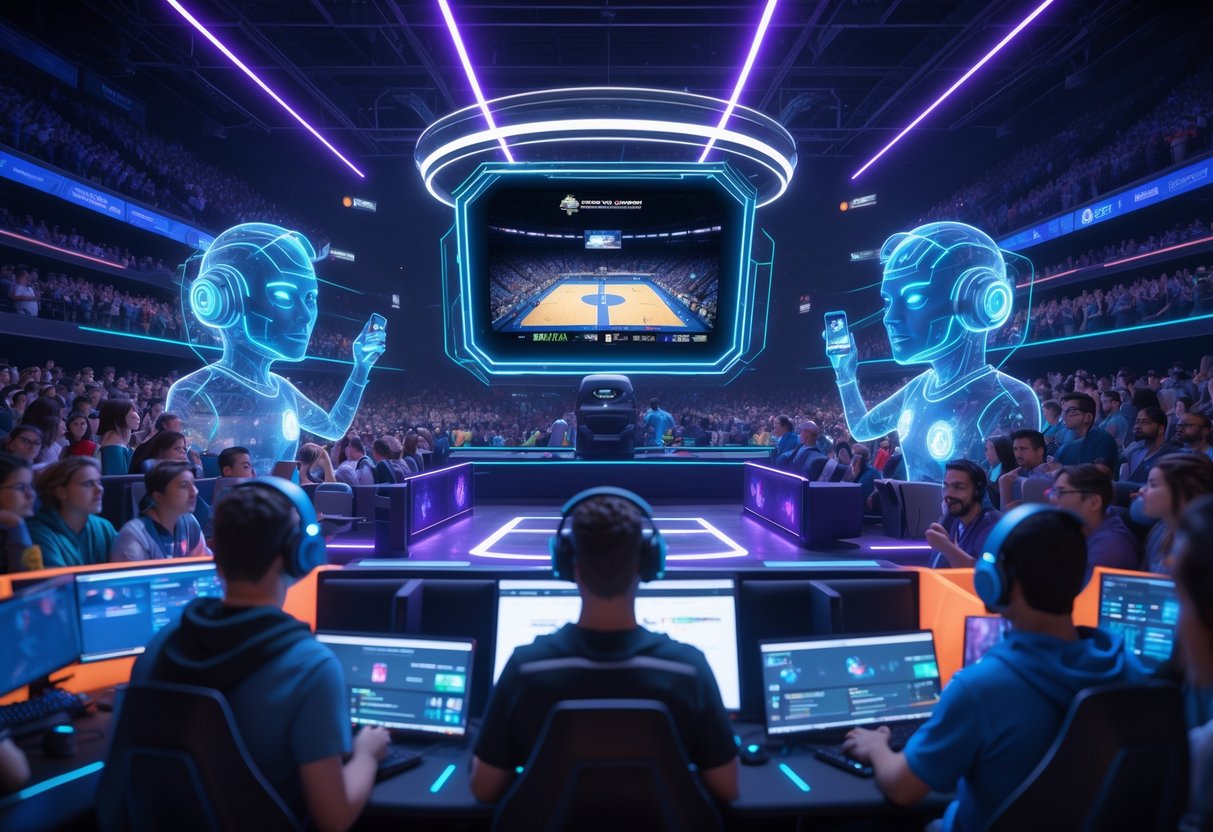
AI commentary is tearing down old barriers in esports broadcasting. It makes matches accessible to more people and delivers consistent analysis every time.
The tech tackles problems like language barriers, bias, and community engagement. Both viewers and organisers get something out of it.
Accessibility and Multilingual Capabilities
AI commentary can translate match analysis into dozens of languages instantly. A League of Legends tournament now reaches fans in Korea, Brazil, and the UK all at once—no need for huge commentary teams.
The savings are big. Traditional multi-language broadcasts need native speakers, translators, and extra crew. AI cuts those costs by about 70% and keeps the quality up.
Quick win: Smaller tournaments now offer commentary in languages they couldn’t afford before. Regional events in Poland or Thailand can add English commentary and attract global viewers.
The tech also helps new fans make sense of complex games. AI adjusts its commentary for each viewer, explaining basics for beginners and going deep for veterans.
Common benefits include:
- Real-time translation
- Consistent terms across languages
- 24/7 commentary for reruns
- Customisable complexity levels
Bias Reduction and Neutral Analysis
Human commentators tend to favor popular teams or players, which can really annoy fans cheering for the underdogs. AI commentary, on the other hand, sticks to objective analysis by focusing on gameplay data and stats.
The system tracks things like kill-death ratios, objective control, and team positioning without getting emotionally involved. Smaller teams finally get the same analytical attention as the big names.
Warning: Some fans genuinely miss the excitement that passionate human commentators bring. AI can feel a bit sterile during those nail-biting moments when you want to hear someone yell.
Gaming expert James Connolly points out that AI works best alongside humans: “The data analysis is spot-on, but you still need human insight for storytelling and building narrative tension.”
Tournament organizers appreciate the reliability. AI doesn’t have off days, personal drama, or risky opinions that might hurt the event’s reputation. Every match gets professional-quality commentary—no matter how important or overlooked it seems.
Audience Feedback and Community Models
AI commentary systems learn directly from how viewers interact and what they say in chat. They shift focus based on what grabs the audience during each match.
Community integration features:
- Real-time chat analysis to spot big plays
- Viewer polls for commentary topics
- Custom tracks for different skill levels
- Social media sentiment tracking
This tech opens up new ways for the community to get involved. Viewers can request player stats or ask for strategy explanations, and AI responds instantly—by text or voice.
In practice, fans watching a Counter-Strike match can ask about a player’s recent performance and get immediate stat breakdowns. That kind of interactivity just wasn’t possible with old-school broadcasts.
Some esports communities use AI to teach newcomers. New players watch pro matches while AI explains decisions and strategies in real time.
The feedback loop keeps improving things. AI tracks which explanations actually help viewers and tweaks its approach as it goes.
Future Trends in AI Commentary for Esports
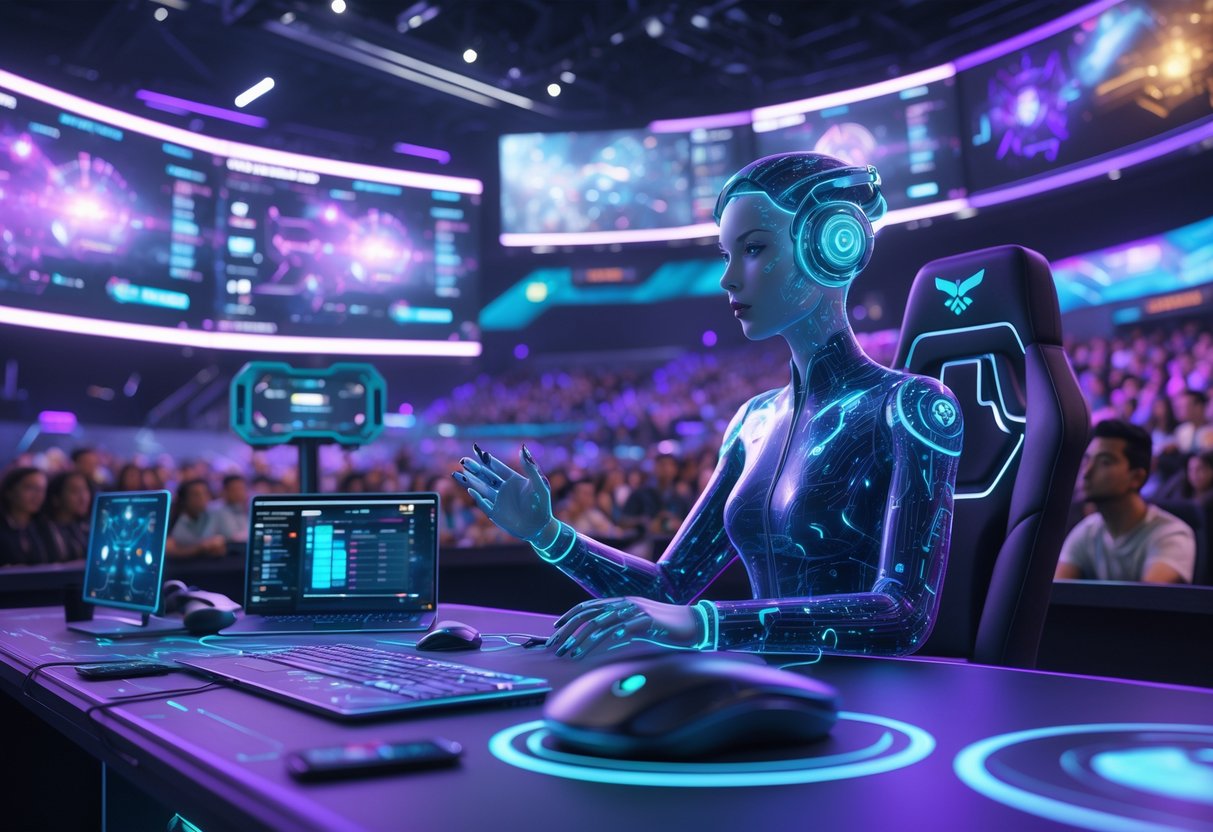
AI commentary tech is hitting a big turning point. Generative AI systems now deliver more human-like analysis, and interactive features let fans personalize how they watch. Honestly, it’s wild to think how much this could change for millions of esports fans in just a few years.
Rise of Generative AI and Adaptive Systems
Generative AI models now adapt their commentary in real time to match the action’s intensity. These systems process thousands of match frames every second and spit out contextual insights.
Current capabilities include:
- Voice tone changes during clutch plays
- Custom commentary styles (analytical or entertaining)
- Instant translation in 50+ languages
Advanced AI models train on specific player patterns. Teams even practice against bots that mimic their real opponents’ strategies.
The tech processes live match data using APIs from games like League of Legends and CS. Commentary naturally references current patch notes, player stats, and community lingo.
Training improvements:
- Models learn from pro caster archives
- Frame-by-frame analysis spots key moments
- Context-aware scripts automatically use game metadata
Opportunities for Enhanced Fan Interaction
Interactive AI commentary lets viewers pick their favorite analysis style during streams. Fans can choose tactical breakdowns, casual chat, or pure hype.
AI-generated overlays create personalized viewing. You get win probability charts, side-by-side player stats, and graphics that update as the match unfolds.
Fan customization options:
- Multiple commentary tracks at once
- Real-time stat overlays tailored to each viewer
- Community voting on AI commentator personalities
Mobile integration means fans can ask questions mid-match. The AI answers instantly about player builds, strategies, or standings.
Now, even small tournaments can offer pro-level commentary. Independent organizers don’t need to hire expensive talent or production teams anymore.
Predictions for Upcoming AI Innovations
By 2027, multi-language commentary will just be standard. AI will instantly adapt regional slang and gaming terms—Portuguese streams become Japanese with zero lag or loss in quality.
Expected developments:
- Emotion recognition in player cams
- Predictive team strategy analysis mid-match
- Integration with virtual and augmented reality
AI models will analyze player biometrics to predict clutch potential or performance dips. Commentary will reference heart rate, eye tracking, and reaction time during crucial plays.
Organizers will use AI to create hundreds of regional streams at once. Each one tweaks its style for local tastes and commentary preferences.
Content creators will get “DIY analysis” tools that turn their gameplay into pro-level breakdowns. These systems spot improvement areas and auto-highlight awesome plays.
The tech is moving toward community-driven model marketplaces. Fans will vote for their favorite AI commentator personalities and styles.
Notable AI Commentary Tools and Providers
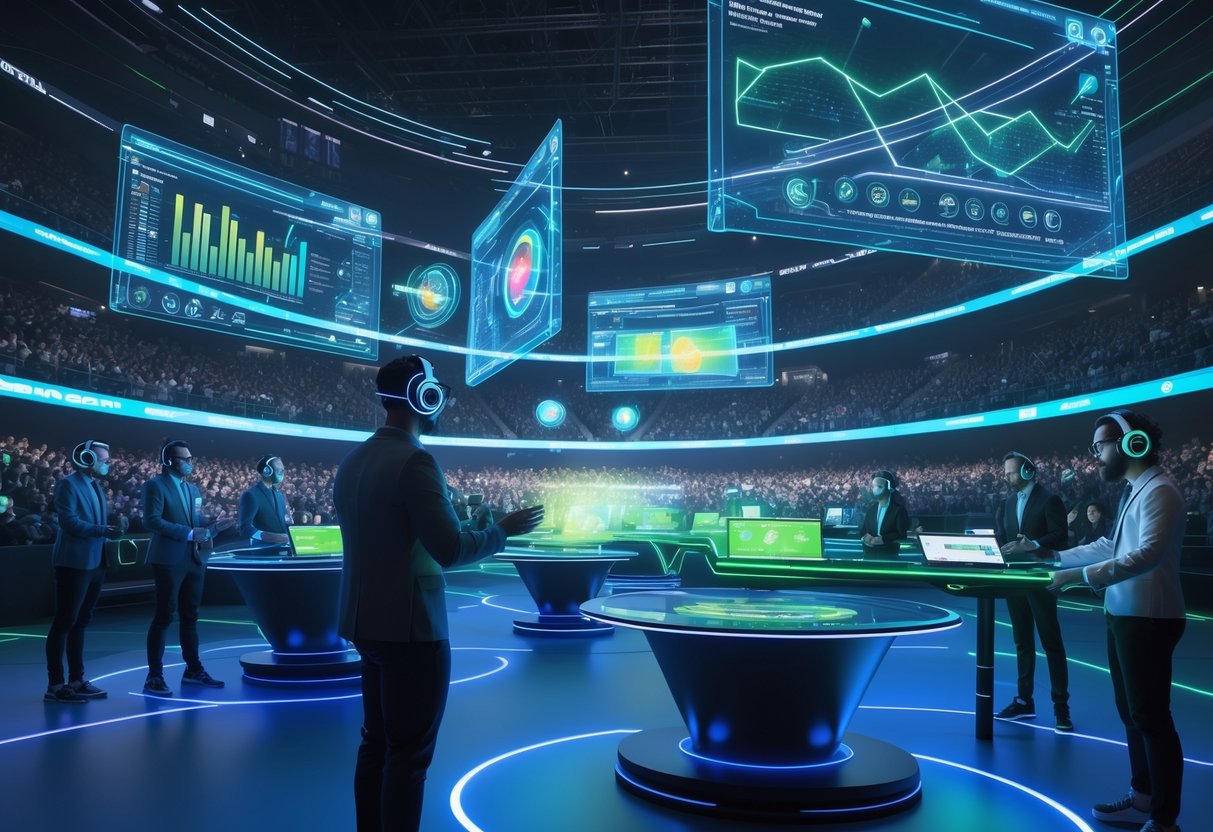
Several companies now offer AI commentary solutions built for esports. Some focus on real-time analysis, others on automated highlight reels. The best tools plug right into streaming platforms and have already proven themselves at big tournaments.
Overview of Leading AI Commentary Solutions
Pixellot is one of the most established providers out there. By 2023, they’d deployed AI systems for over 5 million automated broadcasts. Their platform combines automated cameras with commentary generation.
AWS and IBM both offer enterprise-level solutions. AWS teamed up with the German Bundesliga to cover over 1,600 unique in-game actions per match. IBM’s system handled the 2023 US Open, generating highlights for all 254 singles matches.
Some emerging platforms target esports directly:
- AI Commentary Generator tools create instant voice content
- Sentience AI focuses on drama and player analysis
- Lunara specializes in multilingual commentary for global audiences
Key features on leading platforms:
- Real-time event detection with computer vision
- Natural language processing for storytelling
- Multi-language support
- Customizable commentary styles and tones
Integration with Streaming Platforms
Most AI commentary tools hook right into Twitch, YouTube Gaming, and Discord. Streamers just add pro-level commentary without hiring analysts.
Technical requirements are pretty simple. Streamers need:
- A stable internet connection (at least 10 Mbps upload)
- Compatible streaming software (OBS, Streamlabs)
- API access to the AI platform
LiveKit and Cerebrium offer real-time video commentary with emotional cues. Their systems watch gameplay and generate commentary that matches the moment’s intensity.
Costs vary a lot. Basic AI commentary runs around £15-30 per month for solo streamers. Enterprise packages for tournaments can hit £500-2,000+ per event, depending on audience and languages.
Integration usually takes 30-60 minutes if you’re experienced. Most platforms have plugins that connect automatically to popular streaming tools.
Case Studies of Successful Implementations
German Bundesliga (2024) saw the largest AI commentary rollout in sports. AWS’s system generates real-time multilingual updates, tweaking tone and style for different audiences. The platform processes matches instantly and delivers commentary in German, English, and more—all at once.
Research projects show strong results. A 2025 basketball study combined computer vision with GPT-4 to create commentary that matched pro broadcast quality. The AI analyzed video feeds and produced narration on par with human experts.
IBM’s tennis coverage at major tournaments proves scalability. Their AI generated highlight packages for every match within minutes. It matched 82% of pro summaries while delivering results 15 times faster.
Esports tournaments now use AI for secondary language streams. Organizers report big cost savings compared to hiring multiple human teams. One mid-tier event cut commentary costs by 60% and expanded to five languages.
Success metrics from early adopters:
- 40-70% lower commentary production costs
- 3-5x faster highlight reel creation
- More language coverage without the usual jump in costs
Frequently Asked Questions
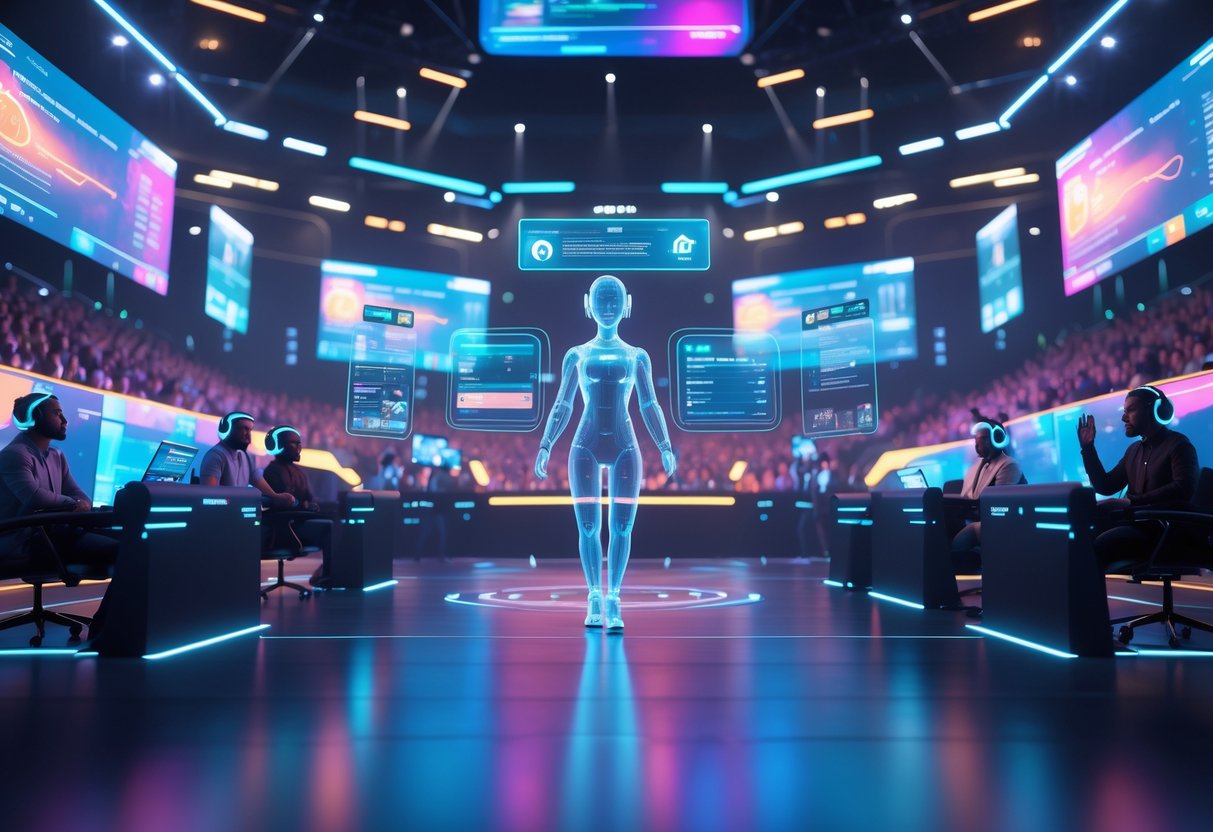
AI commentary brings instant analysis, multi-language support, and cost-effective production to esports. These systems process live gameplay data and adapt their style for different games and tournament formats.
How do AI commentary systems enhance the viewing experience for eSports fans?
AI commentary lets us personalize our viewing in ways traditional broadcasts just can’t. We pick the commentary style—analytical, casual, whatever fits our mood.
The tech gives instant stats and context during matches. When a player makes a huge play, AI instantly pulls up relevant data like win rates and past performance.
Multi-language support opens tournaments up to global audiences. A CS match can be broadcast in Japanese, Portuguese, and English at the same time—no extra human teams needed.
Dynamic overlays show real-time probability charts and player comparisons. These visuals help newcomers understand strategies and keep veteran fans engaged with detailed metrics.
What technological advancements have allowed AI to generate live commentary in sports events?
Large language models like GPT-5 now get gaming terminology and context. These systems pick up on community slang, patch notes, and meta shifts to provide relevant commentary.
Computer vision analyzes video frames in real time and spots key moments. The AI recognizes ultimates in Overwatch 2 or clutch rounds in Valorant without any human help.
APIs pull live match data from places like OpenDota and Riot Games. This keeps commentary synced perfectly with in-game events and player stats.
Text-to-speech tech now sounds broadcast-quality. Modern voice synthesis feels natural and adjusts tone to match the action, even mimicking human excitement.
Can AI commentators adapt their commentary style for different types of sports, including eSports?
AI systems train on game-specific datasets to pick up each sport’s unique aspects. A CS model learns about economy management, while a League of Legends model focuses on team comps.
Commentary style shifts based on match pace and audience. Fast games like Rocket League get energetic play-by-play, while strategic games like Dota 2 get deeper analysis.
Custom voice personas let organizers match their brand. You can pick analytical experts for pro streams or more entertaining personalities for casual broadcasts.
Model marketplaces allow fine-tuning for niche games and regional preferences. Smaller esports communities can develop commentary that gets their specific lingo and strategies.
What are the benefits of using AI-driven commentary over traditional human commentators?
Cost reduction is the big one for organizers. AI cuts out travel, talent fees, and scheduling headaches that come with human teams.
Every broadcast gets the same professional quality, no matter the tournament size. Regional leagues can access the same level of commentary as world championships—budget doesn’t get in the way.
Bias-free analysis means all teams and players get fair coverage. AI judges performance objectively, without favoritism or personal connections.
Scalability lets one AI system cover 100+ matches at once. Human commentators just can’t keep up with that kind of volume.
How do free AI commentary services compare with premium ones in terms of quality?
Free services usually offer basic play-by-play with limited customization. They’re fine for casual creators but don’t have advanced features like custom voice training.
Premium platforms deliver deeper analysis, custom model training, and high-quality voice synthesis. Services like Reelmind.ai offer marketplaces and specialized esports templates.
Voice quality really sets them apart. Free tools often sound robotic, while premium services hit broadcast-level naturalness with real emotional range.
Data integration is another big difference. Free tools mostly analyze the screen, but premium platforms hook directly into game APIs for accurate stats.
Are there notable examples of AI commentary being successfully integrated into major eSports tournaments?
Right now, the main use of AI in eSports seems to revolve around highlight reels and post-match analysis. Big tournaments rely on AI to whip up automated recap videos and break down stats for fans.
Streaming platforms have started to play around with AI-powered overlays during broadcasts. These overlays add extra context, but honestly, they don’t replace human commentators—at least not yet.
Some regional leagues jump on AI commentary faster than the big-name tournaments do. Smaller organizations lean into these tools to give their coverage a professional edge without blowing the budget.
Plenty of content creators also use AI for gameplay analysis videos. You’ll see lots of streamers generating commentary for their highlight reels with automated systems, and honestly, it shows the tech is getting pretty capable.

